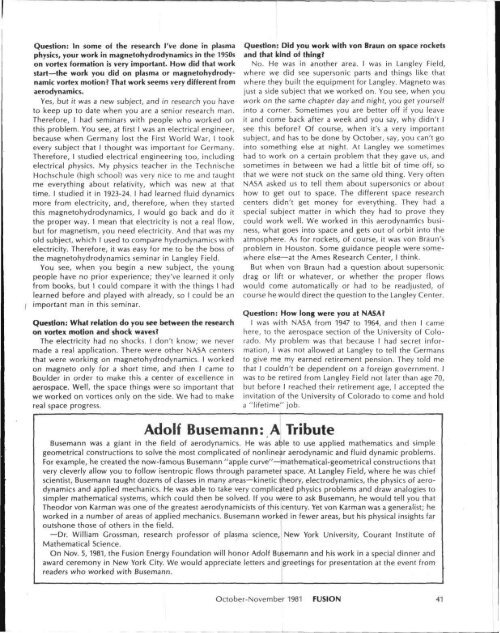Riemann's Contribution to Flight and Laser Fusion
Riemann's Contribution to Flight and Laser Fusion
Riemann's Contribution to Flight and Laser Fusion
- No tags were found...
Create successful ePaper yourself
Turn your PDF publications into a flip-book with our unique Google optimized e-Paper software.
Question: In some of the research I've done in plasmaphysics, your work in magne<strong>to</strong>hydrodynamics in the 1950son vortex formation is very important. How did that workstart—the work you did on plasma or magne<strong>to</strong>hydrodynamicvortex motion? That work seems very different fromaerodynamics.Yes, but it was a new subject, <strong>and</strong> in research you have<strong>to</strong> keep up <strong>to</strong> date when you are a senior research man.Therefore, I had seminars with people who worked onthis problem. You see, at first I was an electrical engineer,because when Germany lost the First World War, I <strong>to</strong>okevery subject that I thought was important for Germany.Therefore, I studied electrical engineering <strong>to</strong>o, includingelectrical physics. My physics teacher in the TechnischeHochschule (high school) was very nice <strong>to</strong> me <strong>and</strong> taughtme everything about relativity, which was new at thattime. I studied it in 1923-24. I had learned fluid dynamicsmore from electricity, <strong>and</strong>, therefore, when they startedthis magne<strong>to</strong>hydrodynamics, I would go back <strong>and</strong> do itthe proper way. I mean that electricity is not a real flow,but for magnetism, you need electricity. And that was myold subject, which I used <strong>to</strong> compare hydrodynamics withelectricity. Therefore, it was easy for me <strong>to</strong> be the boss ofthe magne<strong>to</strong>hydrodynamics seminar in Langley Field.You see, when you begin a new subject, the youngpeople have no prior experience; they've learned it onlyfrom books, but I could compare it with the things I hadlearned before <strong>and</strong> played with already, so I could be animportant man in this seminar.Question: What relation do you see between the researchon vortex motion <strong>and</strong> shock waves?The electricity had no shocks. I don't know; we nevermade a real application. There were other NASA centersthat were working on magne<strong>to</strong>hydrodynamics. I workedon magne<strong>to</strong> only for a short time, <strong>and</strong> then I came <strong>to</strong>Boulder in order <strong>to</strong> make this a center of excellence inaerospace. Well, the space things were so important thatwe worked on vortices only on the side. We had <strong>to</strong> makereal space progress.Question: Did you work with von Braun on space rockets<strong>and</strong> that kind of thing?No. He was in another area. I was in Langley Field,where we did see supersonic parts <strong>and</strong> things like thatwhere they built the equipment for Langley. Magne<strong>to</strong> wasjust a side subject that we worked on. You see, when youwork on the same chapter day <strong>and</strong> night, you get yourselfin<strong>to</strong> a corner. Sometimes you are better off if you leaveit <strong>and</strong> come back after a week <strong>and</strong> you say, why didn't Isee this before? Of course, when it's a very importantsubject, <strong>and</strong> has <strong>to</strong> be done by Oc<strong>to</strong>ber, say, you can't goin<strong>to</strong> something else at night. At Langley we sometimeshad <strong>to</strong> work on a certain problem that they gave us, <strong>and</strong>sometimes in between we had a little bit of time off, sothat we were not stuck on the same old thing. Very oftenNASA asked us <strong>to</strong> tell them about supersonics or abouthow <strong>to</strong> get out <strong>to</strong> space. The different space researchcenters didn't get money for everything. They had aspecial subject matter in which they had <strong>to</strong> prove theycould work well. We worked in this aerodynamics business,what goes in<strong>to</strong> space <strong>and</strong> gets out of orbit in<strong>to</strong> theatmosphere. As for rockets, of course, it was von Braun'sproblem in Hous<strong>to</strong>n. Some guidance people were somewhereelse—at the Ames Research Center, I think.But when von Braun had a question about supersonicdrag or lift or whatever, or whether the proper flowswould come au<strong>to</strong>matically or had <strong>to</strong> be readjusted, ofcourse he would direct the question <strong>to</strong> the Langley Center.Question: How long were you at NASA?I was with NASA from 1947 <strong>to</strong> 1964, <strong>and</strong> then I camehere, <strong>to</strong> the aerospace section of the University of Colorado.My problem was that because I had secret information,I was not allowed at Langley <strong>to</strong> tell the Germans<strong>to</strong> give me my earned retirement pension. They <strong>to</strong>ld methat I couldn't be dependent on a foreign government. Iwas <strong>to</strong> be retired from Langley Field not later than age 70,but before I reached their retirement age, I accepted theinvitation of the University of Colorado <strong>to</strong> come <strong>and</strong> holda "lifetime" job.Adolf Busemann: A TributeBusemann was a giant in the field of aerodynamics. He was able <strong>to</strong> use applied mathematics <strong>and</strong> simplegeometrical constructions <strong>to</strong> solve the most complicated of nonlinear aerodynamic <strong>and</strong> fluid dynamic problems.For example, he created the now-famous Busemann "apple curve"—mathematical-geometrical constructions thatvery cleverly allow you <strong>to</strong> follow isentropic flows through parameter space. At Langley Field, where he was chiefscientist, Busemann taught dozens of classes in many areas—kinetic theory, electrodynamics, the physics of aerodynamics<strong>and</strong> applied mechanics. He was able <strong>to</strong> take very complicated physics problems <strong>and</strong> draw analogies <strong>to</strong>simpler mathematical systems, which could then be solved. If you were <strong>to</strong> ask Busemann, he would tell you thatTheodor von Karman was one of the greatest aerodynamicists of this century. Yet von Karman was a generalist; heworked in a number of areas of applied mechanics. Busemann worked in fewer areas, but his physical insights faroutshone those of others in the field.—Dr. William Grossman, research professor of plasma science, New York University, Courant Institute ofMathematical Science.On Nov. 5,1981, the <strong>Fusion</strong> Energy Foundation will honor Adolf Busemann <strong>and</strong> his work in a special dinner <strong>and</strong>award ceremony in New York City. We would appreciate letters <strong>and</strong> greetings for presentation at the event fromreaders who worked with Busemann.Oc<strong>to</strong>ber-November 1981 FUSION 41
















